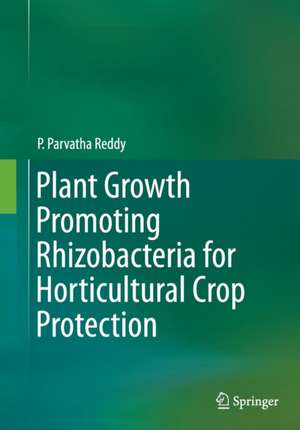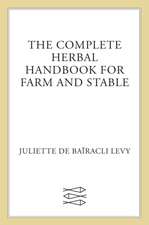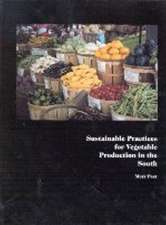Plant Growth Promoting Rhizobacteria for Horticultural Crop Protection
Autor P. Parvatha Reddyen Limba Engleză Paperback – 10 sep 2016
The information on biomanagement of pests (insect and nematode pests, fungal, bacterial and viral/phytoplasma diseases) of horticultural crops (fruits, vegetables, plantation, spice, tuber, ornamental, medicinal and aromatic crops) using PGPR is very much scattered. There is no book at present which comprehensively and exclusively deals with the above aspects on horticultural crops. The present book deals with biomanagement of pests in horticultural crops in detail using PGPR. The present book deals with biomanagement of pests in horticultural crops in detail using PGPR. The present book is divided into six sections. The first section deals with the importance of PGPR including introduction, potential role of PGPR in agriculture, genera of PGPR, disease management, nematode management, insect pest management, integrated pest management, mechanism of biocontrol, mass production, formulation, delivery and commercialization. Pest management in tropical, sub-tropical and temperate fruit crops is dealt in Section II. The third section deals with pest management in Solanaceous, bulbous, Malvaceous, Cruciferous, Leguminous, Cucurbitaceous, leafy and root and tuber vegetable crops. Pest management in plantation and spice crops is in Section IV. Section V deals with pest management in ornamental, medicinal and aromatic crops. The last section deals with a road map ahead including challenges, future prospective and conclusions. The book is extensively illustrated with excellent quality photographs enhancing the quality of publication. The book is written in lucid style, easy to understand language along with adoptable recommendations involving eco-friendly components of IPM.
| Toate formatele și edițiile | Preț | Express |
|---|---|---|
| Paperback (1) | 1113.39 lei 6-8 săpt. | |
| Springer India – 10 sep 2016 | 1113.39 lei 6-8 săpt. | |
| Hardback (1) | 1120.81 lei 6-8 săpt. | |
| Springer India – 15 dec 2014 | 1120.81 lei 6-8 săpt. |
Preț: 1113.39 lei
Preț vechi: 1357.80 lei
-18% Nou
Puncte Express: 1670
Preț estimativ în valută:
213.11€ • 231.57$ • 179.13£
213.11€ • 231.57$ • 179.13£
Carte tipărită la comandă
Livrare economică 21 aprilie-05 mai
Preluare comenzi: 021 569.72.76
Specificații
ISBN-13: 9788132235408
ISBN-10: 8132235401
Pagini: 329
Ilustrații: XIX, 310 p. 219 illus., 146 illus. in color.
Dimensiuni: 178 x 254 x 18 mm
Greutate: 0.58 kg
Ediția:Softcover reprint of the original 1st ed. 2014
Editura: Springer India
Colecția Springer
Locul publicării:New Delhi, India
ISBN-10: 8132235401
Pagini: 329
Ilustrații: XIX, 310 p. 219 illus., 146 illus. in color.
Dimensiuni: 178 x 254 x 18 mm
Greutate: 0.58 kg
Ediția:Softcover reprint of the original 1st ed. 2014
Editura: Springer India
Colecția Springer
Locul publicării:New Delhi, India
Cuprins
Section I: Importance of Plant Growth Promoting Rhizobacteria.- 1. Introduction.- 2. Potential Role of PGPR in Agriculture.- 3. Pest Management.- 4. Mechanism of Biocontrol.- 5. Mass Production, Formulation, Delivery and Commercialization.- Section II: Pest Management in Fruit Crops.- 6. Tropical Fruit Crops.- 7. Sub-Tropical and Temperate Fruit Crops.- Section III: Pest Management in Vegetable Crops.- 8. Solanaceous Vegetable Crops.- 9. Bulbous, Crucuferous and Malvaceous Vegetable Crops.- 10. Leguminous Vegetable Crops.- 11. Cucurbitaceous Vegetable Crops.- 12. Leafy and Root and Tuber Vegetable Crops.- Section IV: Pest Management in Plantation and Spice Crops.- 13. Plantation Crops.- 14. Spice Crops.- Section V: Pest Management in Ornamental, Medicinal and Aromatic Crops.- 15. Ornamental and Aromatic Crops.- 16. Medicinal Crops.- Section VI: A Road Map Ahead.- 17. Challenges, Future Prospects and Conclusions.- Subject Index.
Notă biografică
Dr. P. Parvatha Reddy obtained his doctorate degree jointly from the University of Florida, USA and the University of Agricultural Sciences, Bangalore. He served as the Director of the prestigious Indian Institute of Horticultural Research (IIHR), Bangalore from 1999 to 2002 during which period the Institute was honored with “ICAR Best Institution Award”. Dr. Reddy also served as the Head, Division of Entomology and Nematology at IIHR and gave tremendous impetus and direction to research, extension and education in developing bio-Intensive integrated pest management strategies in horticultural crops. These technologies are being practiced widely by the farmers across the country since they are effective, economical, eco-friendly and residue-free. Dr. Reddy has about 34 years of experience working with horticultural crops and involved in developing an F1 tomato hybrid “Arka Varadan” resistant to root-knot nematodes. Dr. Reddy has over 250 scientific publications to his credit, whichalso include 30 books. He has also guided two Ph.D. students at the University of Agricultural Sciences, Bangalore.
At present, Dr. Reddy is serving as Chairman, Research Advisory Committee (RAC) of the Indian Institute of Vegetable Research, Varanasi; Member of the RAC of the National Centre for Integrated Pest Management, New Delhi; Member of the Expert Panel for monitoring the research program of National Initiative on Climate Resilient Agriculture (NICRA) in the theme of Horticulture including Pest Dynamics and Pollinators; Member, QRT to review the progress of the Central Tuber Crops Research Institute, Trivandrum and AICRP on Tuber Crops.
Dr. Reddy has been awarded with the prestigious “Association for Advancement Pest Management in Horticultural Ecosystems Award”, Dr. G.I. D’souza Memorial Lecture Award”, “Prof. H.M. Shah Memorial Award” and “ Hexamar Agricultural Research and Development Foundation Award” for his unstinted efforts in developing sustainable, bio-Intensive and eco-friendly integrated pest management strategies in horticultural crops.
At present, Dr. Reddy is serving as Chairman, Research Advisory Committee (RAC) of the Indian Institute of Vegetable Research, Varanasi; Member of the RAC of the National Centre for Integrated Pest Management, New Delhi; Member of the Expert Panel for monitoring the research program of National Initiative on Climate Resilient Agriculture (NICRA) in the theme of Horticulture including Pest Dynamics and Pollinators; Member, QRT to review the progress of the Central Tuber Crops Research Institute, Trivandrum and AICRP on Tuber Crops.
Dr. Reddy has been awarded with the prestigious “Association for Advancement Pest Management in Horticultural Ecosystems Award”, Dr. G.I. D’souza Memorial Lecture Award”, “Prof. H.M. Shah Memorial Award” and “ Hexamar Agricultural Research and Development Foundation Award” for his unstinted efforts in developing sustainable, bio-Intensive and eco-friendly integrated pest management strategies in horticultural crops.
Textul de pe ultima copertă
The use of synthetic pesticides has undoubtedly resulted in the achievement of increased crop production. However, in recent times, there has been a considerable pressure on consumers and farmers to reduce or eliminate the use of synthetic pesticides in horticulture, since fruits and vegetables are consumed afresh. This concern has encouraged looking for better alternatives which are cheaper and eco-friendly than synthetic pesticides. It is well known that plant growth promoting rhizobacteria (PGPR) play an important role in maintaining crop and soil health through versatile mechanisms. There are two main outcomes or effects from beneficial microorganisms: enhanced plant growth and crop protection, both of which represent the two main constraints to agriculture.
The information on biomanagement of pests (insect and nematode pests, fungal, bacterial and viral/phytoplasma diseases) of horticultural crops (fruits, vegetables, plantation, spice, tuber, ornamental, medicinal and aromatic crops) using PGPR is very much scattered. There is no book at present which comprehensively and exclusively deals with the above aspects on horticultural crops. The present book deals with biomanagement of pests in horticultural crops in detail using PGPR. The present book is divided into six sections. The first section deals with the importance of PGPR including introduction, potential role of PGPR in agriculture, genera of PGPR, disease management, nematode management, insect pest management, integrated pest management, mechanism of biocontrol, mass production, formulation, delivery and commercialization. Pest management intropical, sub-tropical and temperate fruit crops is dealt in Section II. The third section deals with pest management in Solanaceous, bulbous, Malvaceous, Cruciferous, Leguminous, Cucurbitaceous, leafy and root and tuber vegetable crops. Pest management in plantation and spice crops is in Section IV. Section Vdeals with pest management in ornamental, medicinal and aromatic crops. The last section deals with a road map ahead including challenges, future prospective and conclusions. The book is extensively illustrated with excellent quality photographs enhancing the quality of publication. The book is written in lucid style, easy to understand language along with adoptable recommendations involving eco-friendly components of IPM.
The information on biomanagement of pests (insect and nematode pests, fungal, bacterial and viral/phytoplasma diseases) of horticultural crops (fruits, vegetables, plantation, spice, tuber, ornamental, medicinal and aromatic crops) using PGPR is very much scattered. There is no book at present which comprehensively and exclusively deals with the above aspects on horticultural crops. The present book deals with biomanagement of pests in horticultural crops in detail using PGPR. The present book is divided into six sections. The first section deals with the importance of PGPR including introduction, potential role of PGPR in agriculture, genera of PGPR, disease management, nematode management, insect pest management, integrated pest management, mechanism of biocontrol, mass production, formulation, delivery and commercialization. Pest management intropical, sub-tropical and temperate fruit crops is dealt in Section II. The third section deals with pest management in Solanaceous, bulbous, Malvaceous, Cruciferous, Leguminous, Cucurbitaceous, leafy and root and tuber vegetable crops. Pest management in plantation and spice crops is in Section IV. Section Vdeals with pest management in ornamental, medicinal and aromatic crops. The last section deals with a road map ahead including challenges, future prospective and conclusions. The book is extensively illustrated with excellent quality photographs enhancing the quality of publication. The book is written in lucid style, easy to understand language along with adoptable recommendations involving eco-friendly components of IPM.
Caracteristici
Specifically deals with bio management of horticultural crop pests using plant antagonistic rhizobacteria Focuses on the paradigmatic and policy dimensions and call for an innovative approach by analyzing the key themes in a complex and interrelated manner Serves as a useful reference to policy makers, researchers, extension workers and students






